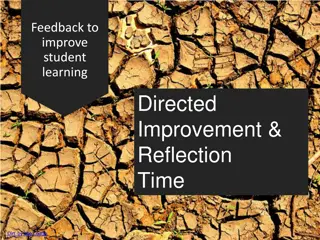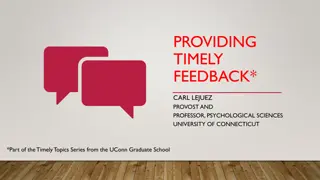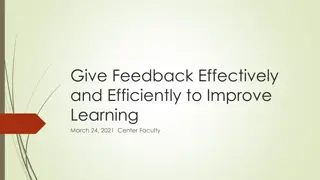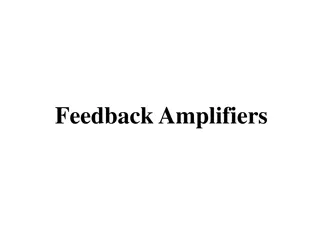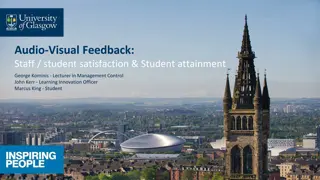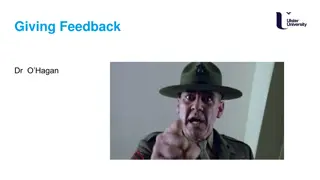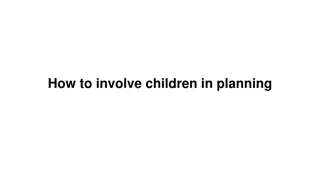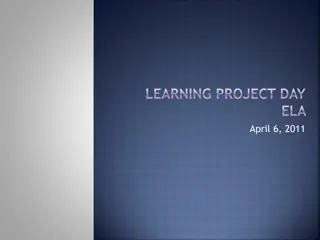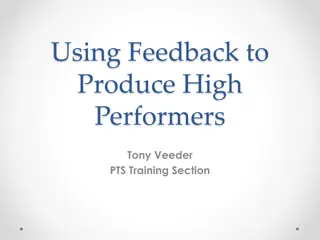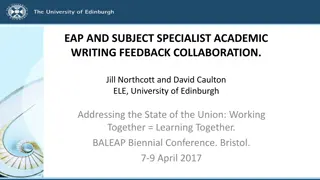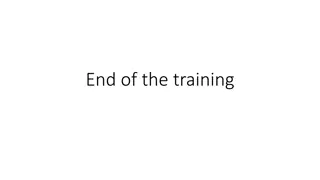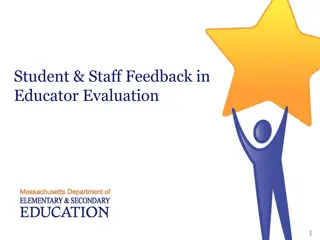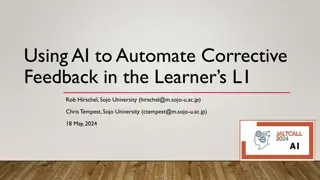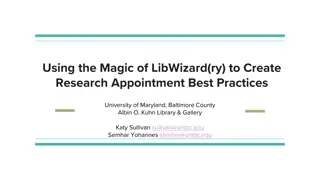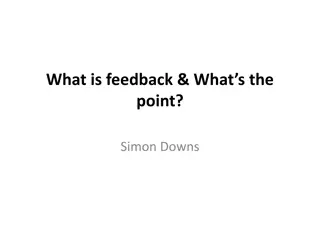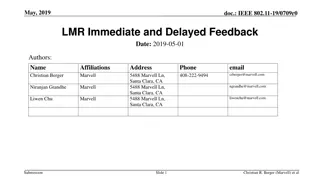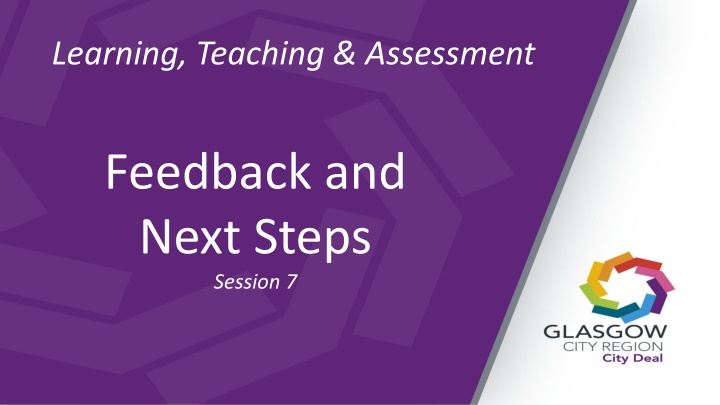
Formative Feedback in Education Sessions
Explore the importance of feedback in education, focusing on formative assessment, effective feedback characteristics, and the impact on learning. Learn how to provide constructive feedback to enhance student outcomes and learning experiences.
Uploaded on | 6 Views
Download Presentation

Please find below an Image/Link to download the presentation.
The content on the website is provided AS IS for your information and personal use only. It may not be sold, licensed, or shared on other websites without obtaining consent from the author. If you encounter any issues during the download, it is possible that the publisher has removed the file from their server.
You are allowed to download the files provided on this website for personal or commercial use, subject to the condition that they are used lawfully. All files are the property of their respective owners.
The content on the website is provided AS IS for your information and personal use only. It may not be sold, licensed, or shared on other websites without obtaining consent from the author.
E N D
Presentation Transcript
Learning, Teaching & Assessment Feedback and Next Steps Session 7
Learning, Teaching and Assessment (Moderation) Cycle
Aims To develop an understanding of the importance of feedback and explore the relationship between success criteria and effective feedback. To identify key features of effective, high-quality feedback and next steps. To consider existing practice and identify areas for improvement.
What do we mean by formative feedback ? Feedback to any pupil should be about the particular qualities of his or her work, with advice on what he or she can do to improve, and should avoid comparisons with other pupils. Inside the Black Box Black & Wiliam (1998)
All formative assessment should include these 3 elements Evidence of where they are now The desired goal Some understanding of how to close the gap
Characteristics of formative feedback Feedback should reference back to the success criteria. It should clearly state areas of strength. Feedback should give direction on how to improve. It should use age and stage appropriate language. It should be appropriately timed, based on observation of learning. Time should be given for the learner to reflect and act upon feedback.
Impact on Learning - The importance of feedback - John Hattie (2015)
Why is feedback important? Ensures learners are clear about what they have done well and what they need to do next to improve through encouragement, support, corrective measures and direction. Ensures learners are engaged in high quality interactions throughout the learning process . Supports learners when target setting/ profiling/personal learning planning (what knowledge and skills they need to develop communicated using SMART) . Provides feedback to teachers of their impact, so they can make adjustments that are critical to the learner experience.
Why is feedback important? Focuses on improvement De-emphasises competition Improves motivation and learning ambition Highlights the difference between actual learning and desired learning.
Types of Feedback Oral Feedback Written Feedback During the lesson / activity Tends to be after the completion of the task Personal and immediate Comments or grades Interactive / 2-way
Types of Feedback Teacher to Pupil Feedback Pupil to Pupil Feedback Pupil to Teacher feedback Learner to teacher feedback is more important than teacher to learner feedback. (Hattie and Clark, 2019)
All the elements of formative assessment come into play as the feedback happens . The success criteria are the key focus for discussing best bits and improvement needs. Talk partners discuss the visualiser work and their own work cooperatively, articulating their thoughts and learning from each other. Outstanding Formative Assessment (Summary) Shirley Clarke (2014)
Pause for thought Effective Oral Feedback Look at the examples of feedback for this lesson. Which ones are effective? Which ones could you improve? Example Activity: Pupils cut out, order and glue pictures of a story in sequence We are learning to: Sequence events Success Criteria: The pictures will be in the same order as the story we read. Feedback 2 Feedback 4 Good job, you have glued that picture very neatly. Feedback 3 Feedback 1 You are getting better at cutting out. Well done! Good strategy, you have cut out all the pictures first so you can shuffle them around and change your mind. Well done. I see you have got the first picture in place. What happened next in the story?
Effective Written Feedback Find 1 or 2 successes against the success criteria . Find the part of the work that has most scope for an immediate jump (not simply the worst part!) Write a short prompt telling the child exactly what to do to this part of their work . Provide time for them to read, process and respond to your prompt.
Effective feedback is at the heart of a formative approach to assessment. Feedback is powerful but variable on its impact on learning. Scores or comments with no focus on improvement might interfere with learning. Prior knowledge is the starting point for feedback. Feedback is about closing the gap between current and desired learning. Learner to teacher feedback is more important than teacher to learner feedback. Effective feedback occurs when it is received and acted upon. Visible Learning: Feedback Hattie and Clarke (2019)
Building feedback into day-to-day learning Mid-lesson reviews using the Success Criteria Sharing examples of work mid-lesson Plenary sessions (hinge questions) Effective questioning and interventions during lessons Discussions and verbal feedback Giving time to respond to written and verbal feedback from previous lesson at the start of the next lesson Opportunities for learners to engage in self and peer assessment. Editing sessions for writing lessons
Building feedback into the learning: from the beginning Effective questioning and interventions during lessons. Starting point for feedback is prior knowledge. What are you going to do first? Tell me what you have done here. Tell me more about So how is this one better than that one? What do you mean by ? Can you develop on that? How could you make this even clearer? Give me an example of what you mean by
Building feedback into the learning: during learning 5 minute walk about to assess level of understanding Make a decision about the best kind of feedback whole class stop - clarify/explain teacher and pupil pupil as teacher teacher and group peer coaching Refocus the learners on the learning intention and success criteria Mid lesson review Display examples on a visualiser/screen cast Review a common mistake
Building feedback into the learning: after learning Discussion with teacher 1 to 1 conversation Peer and self assessment Marking comments - only if they deepen the learning Rotational marking (group a week) Correction codes / marking schemes Whole class feedback Universal comment bank
Demonstrating a commitment to learning for all We need to reinforce a shared belief that all children have the capacity to learn by emphasising progression in learning rather than performance. This can help promote self-belief and personal satisfaction on completion of tasks, because pupils can feel secure in coming up with their own ideas, thinking out loud and explaining their reasoning.
Success Criteria and Feedback Feedback is focused on the agreed set of success criteria. Both learner and practitioner are clear about what is being assessed and what the feedback will be based on. Learning Intention: Use notes to create a new text. Success Criteria I have read my notes carefully to check I understand . I have written using my own words . I have used the headings to structure my text in paragraphs . I have included the key information from my notes. Possible feedback You have used your notes well to organise your writing into paragraphs. You have included the key information. Can you improve the highlighted sections by re-writing them using your own words?
Next Steps What are the next steps if the learner has met the success criteria? Learner has completed a block of work on multiplying 2-digit numbers. Next steps should not simply refer to the next section of teaching. Well done! You have achieved all the success criteria, now you are ready to begin learning about decimals. Next steps should not be about activities.
Next Steps What are the next steps if the learner has met the success criteria? Breadth of learning Challenge in learning Application of learning Learner has completed a block of work on multiplying 2-digit numbers. Learner has been creating notes and researching about life in another country. Well done! You are able to multiply your tens and units digits accurately. You have added them together accurately too. Now you are ready to multiply 3 digits. Can you think how you might do this? Now you might use your notes to create a new text such as a leaflet, to compare life in India with life in Scotland.
Reflective Questions Are the learners receiving on-going feedback on their work? Is this based on the Success Criteria? Does the feedback outline what they did well based on Success Criteria? Does the feedback describe what they need to do to improve based on Success Criteria? Does the feedback state areas of success? Does the feedback state what the learner s next steps are? Does the feedback include a mix of self, peer and practitioner assessment? Are the learner s next steps clear? Could a learner set appropriate targets from the feedback? In what ways is the feedback formative? Is it timely?
Further Information Education Scotland - Moderation Hub - Feedback and Next Steps Carol Dwyer and Dylan Wiliam (2010) - Using Classroom Data to Give Systematic Feedback to Students to Improve Learning Black & Wiliam (1998) - Inside the Black Box John Hattie (2018) - Collective Teacher Efficacy (10 minute video clip) John Hattie and Helen Timperley (2007) - The Power of Feedback Summary of Hattie and Timperley research - The Power of Feedback (4 minute video clip) John Hattie (2017) - Types and Purposes of Feedback (5 minute video clip) Shirley Clark (2013) - Shirley Clarke video on feedback (8 minute video clip) TED Talks with Nick Coles (2019) - Effective Feedback without Marking (23 minute video clip) Ron Berger - Story of Austin s Butterfly - Critique and Feedback (7 minute video clip) Equity, Excellence and Empowerment

